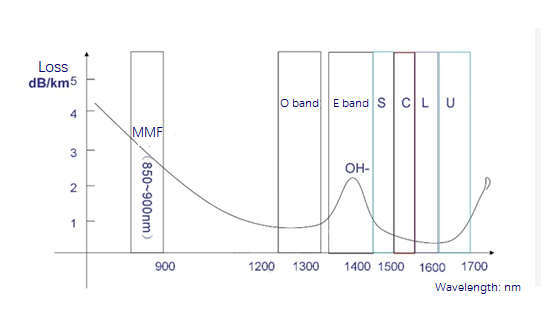Fiber Optic Tech
How to Distinguish O, E, S, C, L, U Band Wavelengths?
What is O-band?
O-band is the original band 1260-1360 nm. O-band is the first wavelength band historically used for optical communications, with minimal signal distortion (due to dispersion).
What is E-band?
E-band (extended wavelength band: 1360-1460 nm) is the least common of these bands. E-band is mainly used as an extension of O-band, but there are few applications, mainly because many existing optical cables show high attenuation in E-band, and the manufacturing process is very energy-intensive, so its use in optical communication is limited.
What is S-band?
The fiber loss in the S-band (Short-wavelength Band) (short-wavelength band: 1460-1530 nm) is lower than that in the O-band, and the S-band is used as many PON (passive optical network) systems.
What is C band?
The C-band (Conventional Band) ranges from 1530 nm to 1565 nm, representing the conventional band. Optical fiber exhibits the lowest loss in the C-band and has a greater advantage in long-distance transmission systems. It is usually used in many metropolitan, long-distance, ultra-long-distance and submarine optical transmission systems combined with WDM and EDFA technology. C-band becomes more and more important as transmission distances become longer and fiber amplifiers are used instead of optical-to-electron-to-optical repeaters. The use of C-band expanded with the advent of DWDM (Dense Wavelength Division Multiplexing), which enables multiple signals to share a single fiber.
What is L-band?
L-band (Long-wavelength Band) (long-wavelength band: 1565-1625 nm) is the second lowest-loss wavelength band and is often used when the C-band is not enough to meet the bandwidth requirements. With the widespread availability of b-doped fiber amplifiers (EDFAs), DWDM systems have been extended up to the L-band, and were initially used to extend the capacity of terrestrial DWDM optical networks. Now, it has been introduced to submarine cable operators to do the same thing - expand the total capacity of submarine cables.

Due to the transmission attenuation loss of the two transmission windows of C-band and L-band is the smallest, the signal light in the DWDM system is usually selected in C-band and L-band. In addition to O-band to L-band, there are two other bands, the 850 nm band and U-band (ultra-long band: 1625-1675 nm). The 850 nm band is the dominant wavelength for multimode fiber optic communication systems incorporating VCSELs (Vertical Cavity Surface Emitting Lasers). The U-band is mainly used for network monitoring.
| Band | Deion | Wavelength Range | Bandwidth |
| O band | Original | 1260-1360nm | 100 |
| E band | Extended | 1360-1460nm | 100 |
| S band | Short Wavelength | 1460-1530nm | 65 |
| O band | Conventional | 1530-1565nm | 40 |
| L band | Long Wavelength | 1565-1625nm | 60 |
| U band | Ultralong Wavelength | 1625-1675nm | 50 |
WDM technology can be divided into WDM, CWDM, and DWDM according to different wavelength modes. The wavelength range specified by ITU for CWDM (ITU-T G.694.2) is 1271 to 1611 nm, but considering the relatively large attenuation of the 1270-1470nm band in the application, the wavelength range of 1470~1610nm is usually used. DWDM channels are more densely spaced, using C-band (1530nm-1565nm) and L-band (1570nm-1610nm) transmission windows. Ordinary WDM generally adopts 1310 and 1550nm wavelengths.



















